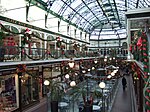Southport Theatre
Buildings and structures in SouthportCulture in MerseysideMerseyside building and structure stubsPerformance art venuesTheatres in Merseyside ... and 2 more
Tourist attractions in MerseysideUnited Kingdom theatre (structure) stubs

Southport Theatre was a theatre in Southport, England owned by Sefton Council. The theatre presented a programme of touring shows, opera and children's shows throughout the year. The theatre was also a popular choice for national and international conferences & exhibitions and underwent a £40m renovation as part of the overall redevelopment of the Southport area.Bliss Space (Southport) Ltd, the lease holder and operating company for Southport Theatre & Convention Centre (STCC) went into liquidation on 19th May 2020.
Excerpt from the Wikipedia article Southport Theatre (License: CC BY-SA 3.0, Authors, Images).Southport Theatre
The Promenade,
Geographical coordinates (GPS) Address Phone number External links Nearby Places Show on map
Geographical coordinates (GPS)
| Latitude | Longitude |
|---|---|
| N 53.652 ° | E -3.006 ° |
Address
The Southport Theatre & Convention Centre
The Promenade
PR9 0DZ
England, United Kingdom
Open on Google Maps











